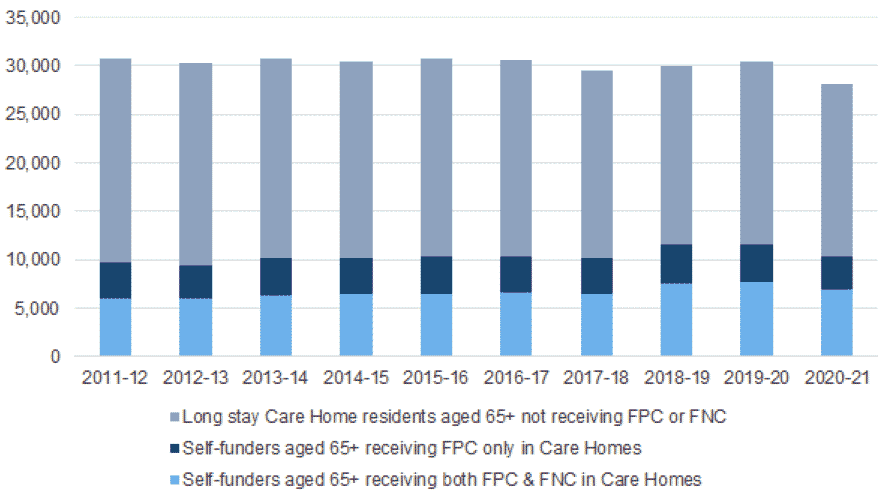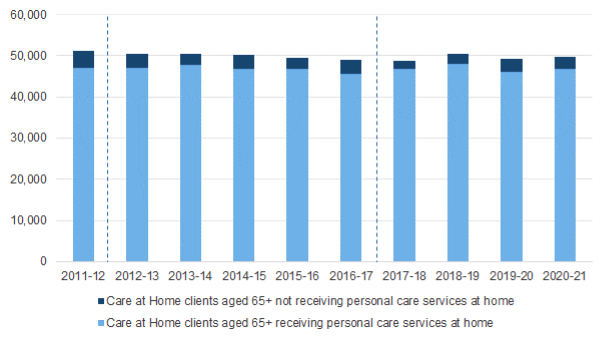Free Personal And Nursing Care, Scotland, 2020-21
Statistics release presenting data on the number of people that benefit from Free Personal Care (FPC) and Free Nursing Care (FNC) in Scotland, and the amount that Local Authorities spend on personal care services.
This document is part of a collection
People receiving Free Personal Care and Free Nursing Care
This section presents the latest available data on the number of residents aged 65 and over receiving FPC and FNC in a Care Home, and people aged 65 and over receiving personal care for free
Please note that figures for 2011-12 are the average across the entire financial year, and figures from 2012-13 show a snapshot of the final week of the financial year only. Please see the Data Sources section for further information.
Historically, this data has included a very small number of Care Home residents aged 18 to 64 who receive FNC payments as part of their care. Due to the format of the quarterly data return and FPC having now been extended to those aged 18 to 64, it is not possible to determine which of these residents aged under 65 receive FNC only. Therefore, from financial year 2018-19 onwards, data below on the number of Care Home residents receiving FPC and FNC relate only to those aged 65 and over.
Care Homes
Since 2002, information has been collected on the number of residents aged 65 and over supported by Local Authorities in Care Homes. Those placed on the National Care Home Contract receive any FPC and FNC they are eligible for as part of this agreement. For self-funders, Local Authorities make weekly payments to cover the costs of providing these services directly to the care provider.
Eligibility for these payments is linked to client age:
- care home residents aged 65 and over who are assessed as self-funders can receive a weekly payment towards their personal care
- people of all ages who live in care homes and are assessed as self-funders can receive a weekly payment if they require nursing care
In 2020-21, there were 10,420 self-funding older people resident in Care Homes receiving FPNC payments, a decrease from 11,560 reported in the previous year and an overall increase of 7% from 9,720 receiving FPNC payments in 2011-12. The highest number of self-funding residents receiving FPNC payments recorded was 11,600 in 2018-19.
As a proportion of all long stay Care Home residents aged 65 and over, 37% were self-funders receiving FPNC payments in 2020-21. This is a slightly smaller proportion than 38% in 2019-20, and an increase overall from 32% in 2011-12.
6,870 of the 10,420 self-funding residents receiving FPNC payments in 2020-21 received both FNC and FPC payments, and 3,550 received FPC payments only. The proportion of residents receiving FPNC payments who receive both FNC and FPC payments has stayed consistent over the latest years, but has increased overall from 62% in 2011-12 to 66% in 2020-21. Therefore, the proportion receving FPC payments only has decreased from 38% in 2011-12 to 34% in 2020-21.
The remainder of residents did not receive either FPC or FNC, or were placed under the National Care Home Contract.
Full data is available in the accompanying tables.
The number of long stay Care Home residents aged 65 and over who receive both FPC and FNC payments, FPC payments only, and who do not receive FPC or FNC payments, Scotland, 2011-12 to 2020-21.

Source: Community Care Quarterly Key Monitoring Return
To put these figures into context, the overall number of long stay residents aged 65 and over supported in Care Homes has reduced by 9% from 2011-12, where there were around 30,750 residents, to 28,120 in 2020-21. From 2011-12 to 2019-20, the number of long stay residents in Care Homes for older adults was fairly consistent, decreasing from 30,420 to 28,120 between 2019-20 and 2020-21.
The COVID-19 pandemic likely contributed to this decrease in the number of Care Home residents in 2020-21. Particular factors that have likely influenced this are deaths due to COVID-19, and willingness of relatives to put relatives into Care Homes during the pandemic. Further information around this is available in the National Records of Scotland Deaths involving Coronavirus publication, and the Care Inspectorate bulletin on Covid-19 related deaths in Care Homes.
Full figures are available in the accompanying tables.
Care at Home
In 2020-21 there were 49,780 older people (aged 65 and over) receiving Care at Home, an increase from 49,160 in 2019-20. Please note that the source of this data has changed from 2017-18, which will impact on comparisons over time. In 2011-12, there were around 51,120 older people receiving personal care services at home.
In 2020-21, around 46,820 older people receiving Care at Home services received personal care services as part of their care package, consistent with 47,010 in 2011-12. Between 2011-12 and 2020-21, the number of clients receiving personal care services varied between a minimum of 45,660 (2016-17) and a maximum of 48,140 (2018-19).
The proportion of older people receiving Care at Home services who received personal care services increased from 92% in 2011-12 to 94% in 2020-21, with the highest proportion (96%) of Care at Home clients receiving personal care services in 2017-18. Full figures are available in the accompanying tables.
People receiving personal care services at home (in all Local Authorities apart from Glasgow City, please see the Data Quality section for more information) received on average 9.8 hours of care per week in 2020-21, an increase from the 9.5 average hours in 2019-20 and 9.5 average hours in 2011-12. The highest number of average hours of personal care services per Care at Home client was 10 in 2016-17.
The number of care Care at Home aged 65 and over receiving personal care services, and the number of Care at Home clients aged 65 and over not receiving personal care services, Scotland, 2011-12 to 2020-21.

Source: Home Care Census 2011-12, Social Care Survey 2012-13 to 2016-17, Community Care Quarterly key monitoring return 2017-18 to 2020-21
Notes: Vertical lines on the chart denote where the source of data has changed as described above
For Local Authorities who were able to provide data, the weekly average number of hours of personal care at home provided in Scotland increased by around 5% from around 389,000 hours in 2011-12 to around 410,000 in 2020-21.
Full figures are available in the accompanying tables.
Contact
Email: SWStat@gov.scot
There is a problem
Thanks for your feedback